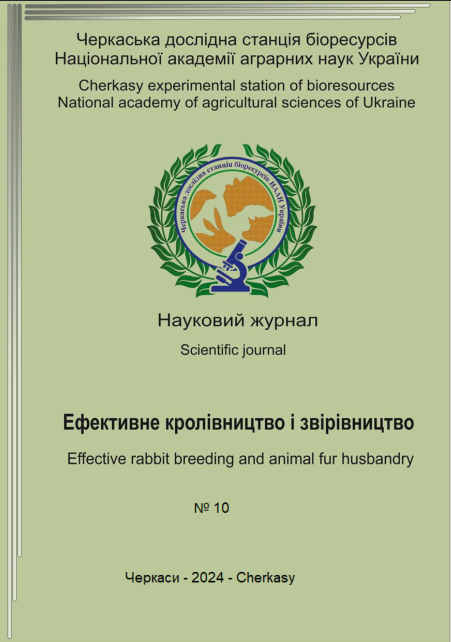SAFETY AND PRODUCTIVE EFFECT OF THE L-CARNITINE PREPARATION ON THE GROWTH
DOI:
https://doi.org/10.37617/2708-0617.2024.10.100-112Keywords:
young rabbits, growth intensity, the drugAbstract
The productive effect of the drug "CarnEon 50" on the intensity of growth of young rabbits was studied. A compound feed recipe was developed based on local feed ingredients: barley grits (10%) and oats (10%), wheat bran (10%), sunflower meal (20%), alfalfa flour (35%), table salt (0.4%), premix (3.1%). For the experiment, 6 groups of young rabbits of 10 heads each (5 males + 5 females) were formed using the pair-analog method.
It was established that when used in the diet of fattening young rabbits "CarnEon 50" in the amount of 150; 200 and 250 g per ton of finished fodder (III, IV and V groups) live weight at 90 days of age increased by 2.9-6.8%, average daily gains - by 4.2-10.5%, lifetime waist width ( meatiness index) – by 3.0-4.5%, feed conversion improved by 2.5-3.9% compared to the first control group.
Young rabbits of the IV and V experimental groups with 200 and 250 g/t of CarnEon 50 in their rations probably outweighed the control group by 124 and 94 g (р<0.01) in terms of paired carcass weight. In terms of slaughter yield, young animals of III, IV and V groups had an advantage over the control group by 1.0 - 1.3%.
The use of the drug "CarnEon 50" in the amount of 200-250 g per ton of compound feed in the diets of young rabbits during intensive production of rabbit meat makes it possible to reduce direct costs for the production of 1 ton of rabbit meat by UAH 800, and to increase the profitability of production by 2%.
References
Антоненко П.П., Постоєнко В.О., Засєкін Д.А. Вплив фітопрепаратів на обмін речовин та продуктивність птиці. Сучасне птахівництво. 2007. № 7. С . 18-19.
Бащенко М.І., Лучин І.С., Бойко О.В., Дармограй Л.М., Гончар О.Ф., Гавриш О.М. Проектування інтенсивного виробництва кролятини в Україні. Монографія. Черкаси: Черкаська дослідна станція біоресурсів НААН, 2019. 212 с.
Гончар О.Ф., Шевченко Є. А. Підвищення продуктивних якостей кролів шляхом застосування пробіотичного препарату Bacillus subtilis. Вісник АПВ НААНУ. 2010. №10. С. 24–29.
Коцюмбас І. Я., Гунчак В. М., Стецько Т.І. Проблеми використання антимікробних препаратів для стимулювання росту продуктивних тварин та альтернативи їх застосуванню. Науково-технічний бюлетень Інституту біології тварин і Державного науково-дослідного контрольного інституту ветпрепаратів та кормових добавок. 2013. Вип. 14. № 3–4. С. 381–389.
Лучин І.С. Комплексний показник оцінки ремонтного молодняку кролів різних генотипних поєднань. Розведення і генетика тварин : міжвід. темат. наук. зб. 2005. Вип. 39. С.128–133.
Колесник М.Д. Використання ехінацеї пурпурової у кормових добавках. Вісник аграрної науки. 2005. № 7. C. 26-28.
Нечаев А.П., Кочеткова А.А. Пищевые и биологически активные добавки, ароматизаторы и технологические вспомогательные средства. Учебное пособие. СПб: ГИОРД, 2007. С. 201-214.
Сучасні технології годівлі свиней без використання антибіотиків [Електорнний ресурс] https://vita.biz.ua/suchasni-tehnologivi-godivli-svvnei-bezvvkorvstannva-antvbiotvkiv/
Abdel-Fattah S. A., El-Sanhoury M. H., El-Mednay N. M. Abdel-Azeem F.Thyroid activity, some blood constituents, organs morphology and performance of broiler chicks fed supplemental organic acids. International Journal of Poultry Science. 2008. Vol. 7 (3) P.215–222.
Butsiak H.A. Butsiak V.I., Gutyj B.V., Kalyn B.M., Muzyka L.I., Stadnytska O.I., Luchyn I.S., Rozputnii O.I., Kachan L.M., Melnichenko Yu. O., Sliusarenko S.V., Bilkevich V.V., Leskiv K.Y. (2021). Migration of heavy metal mobile forms into the plant vegetative mass under anthropogenic load. Ukrainian Journal of Ecology. 11 (1). 329-343, doi: 10.15421/2021_50.
Bojko O.V., Darmohray L.M., Luchyn I.S., Honchar O.F., Gutyj B.V. Specific activity of Sr-90 and Cs-137 in rabbits of various genotypes. Ukrainian Journal of Ecology. 2020. 10 (2). 165-169. doi: 10.15421/2020_80.
Darmohray L.M., Luchyn I.S., Gutyj B.V., Golovach P.I., Zhelavskyi M.M., Paskevych G.A., Vishchur V.Y. (2019).Trace elements transformation in young rabbit muscles. Ukrainian Journal of Ecology. 9 (4). 204-210.
Dibner, J.J. and P. Butin, (2002). Use of organic acids as a model to study the impact of gut microflora on nutrition and metabolism. J. Appl. Poult. Res.11: 453-463.
Hunchak, A., Hunchak, V. M., & Ratych, I. B. (2015). BIOLOGICAL EFFECTS OF PLANTS EXTRACTS IN THE POULTRY. Scientific Messenger of LNU of Veterinary Medicine and Biotechnologies. Series: Veterinary Sciences, 17 (3), 19-31.
Maertes L. Peres J., Villamide M., Cervera C., Gidenne T., Xiccato G. (2004).Nutritive value of raw materials for rabbits : EGRAN tables 2004. World rabbits sci. Vol. 10. Issue 4. P. 157-166.
Samudovska A., Demeterova M. (2010). Effect of water acidification on performance, carcass characteristic andsome variables of intermediary metabolism in chscks. Acta Veterinaria (Beograd). Vol. 60. (№ 4). Р. 363–370.
Soltan M.A. Effect of dietary organic acid supplementation on egg production, egg quality and some blood serum parameters in laying hens. International journal of poultry sciences. Asian network for scientific information. 2008. 7 (6): р. 613-621. ADIMIX
[Електорнний ресурс] http://science.btsau.edu.ua/sites/default/files/specradi/disert lukashuk.pdf


